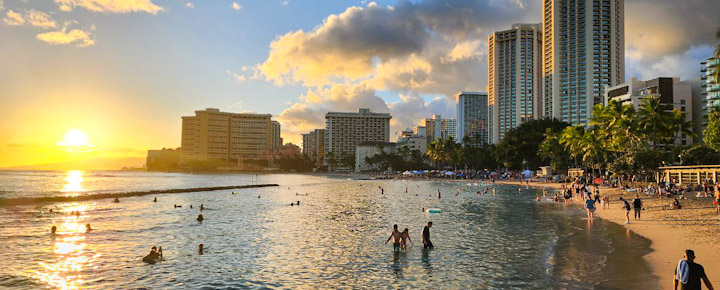When thinking of the crown jewel of Hawaii, our minds typically visualize spectacular beaches. Each has its unique charm, making Hawaii a paradise for beach lovers. Our unique and stunning island archipelago of Hawaii also has many other standouts, like the next one.
This summer, the most famous gem is Hawaii weather.
With record-high temperatures on the mainland this summer, tropical weather conditions have remained in Hawaii, making it a perfect escape. Hideous weather conditions have impacted most of the US, Europe, and elsewhere this summer. We can’t remember a time it has ever dominated the news to this degree.
As the rest of the U.S., dare we say the world, is in the midst of the hottest summer ever, we’re expecting temperatures mainly in the 80’s with refreshing trade winds. Ahh. If you suffer from a case of the triple digits this summer or any summer, you can shut down your AC and head off on your next Hawaii vacation. This is yet another crowning feature of still glorious Hawaii.
Hawaii is the cure for triple-digit forecasts.
Even before this summer’s global heatwaves, that was true. It is mainly due to being many small islands in the middle of a large ocean, with incumbent seasonal and daily variability in Hawaii weather. And, of course, that includes the possibility of Hawaii hurricanes in season, like Hurricane Calvin that recently passed by.
August in Hawaii will be high 80-degree days.
We’re well into the balmy summer months, with slightly warmer high 80-degree days and mid-70-degree nights. Even though Hawaii is closer to the equator than most of the country, the breezy flow of cool air from the Arctic keeps us comfortable year-round, including in summer. Rob, editor of Beat of Hawaii, recently competed in the Hanalei Bay Swim Challenge. In the middle of summer, competitors had a mix of sun, clouds, rain, and cooling tradewinds.
Hawaii’s ocean temperature ranges from 73 to 80 degrees.
The Pacific Ocean is the obvious source of Hawaii’s unique weather. Ocean temperature varies by about 6 degrees from winter to summer, generally between 73 and 80 degrees Fahrenheit. Located some 2,500 from the nearest continental land mass and one of the world’s most remote island chains, Hawaii’s air is moderated by the ocean rather than by land conditions (as is the case on continents).
Hawaii temperatures – what to expect by month.
From October until May (our cool season), expect nighttime temperatures in the 50’s and 60’s and days to drop into the 70’s. Our lowest temperatures are found from February through April.
Plan your vacation around or between Hawaii rainfall.
We usually get major winter rain storms from November to December and March to April. And from November through April, expect at least one month of rain. That comes out to 15 percent precipitation during those six months. When these winter rains occur, they often impact the entire island chain. Intense winter rainfall can also result in runoff that makes the ocean briefly not safe for swimming.
Expect cooling trade winds most of the year.
Cooling trade winds are often driven from the north and east as they cross the state’s higher elevations. As a result of these temperature and humidity moderating trades, the south and west sides are left warmer and dryer, while most of the rain at these times is found in the mountains and valleys.
During trade wind conditions, it is usually possible to escape rain by heading to nearby drier areas. Also, remember that if it’s raining where you are, another part of the island may be sunny and dry.
The trade winds stop, or the winds blow from the south about 20 percent of the time. South or Kona winds in winter often lead to cold and wet conditions. In summer, they lead to higher humidity.
What’s your favorite time of year to enjoy the weather in Hawaii?
Get Breaking Hawaii Travel News







Maui No Ka Oi